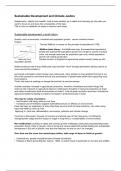Notes de cours
Sustainable development and climate justice lecture notes
- Cours
- Établissement
Very in-depth going into population bomb, Malthus population theory, sustainable development, green growth, degrowth, sdgs, Jeffree sachs, framings of sustainable development and history, public/celebrity framings and critical analysis as well as analysis of climate justice and indigenous forms
[Montrer plus]



